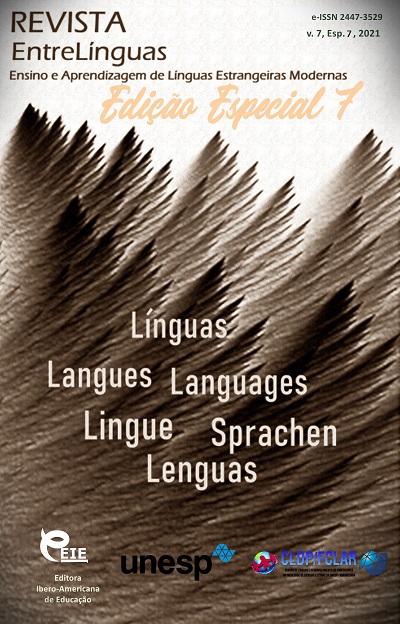La "información confidencial" como marco organizador de la estructura informativa de la novela "Código da Vinci" por D. Brown
DOI:
https://doi.org/10.29051/el.v7iesp.7.16287Palabras clave:
Concepto, Activación de concepto, Estructuras de marco, Ranura, Codificación, Signo, Sistema de símbolos, Campo semántico, Ejes semánticos, Cosmovisión cognitiva, Componentes de significadoResumen
El artículo trata sobre las peculiaridades de la representación del concepto SECRETO en el marco de “Información secreta” que estructura la trama de la novela “Código Da Vinci” de D. Brown. El autor describe el marco antes mencionado y sus sub-marcos sobre la base de los vocabularios lingüísticos y compara el esquema conceptual del campo semántico con el esquema conceptual de la novela determinado por medio del análisis cognitivo del texto. El autor revela la dependencia de las condiciones lexicológicas y gramaticales de los conceptos interrelacionados verbalizados con el desarrollo de la trama y establece la dependencia del desarrollo de la línea temática de los conceptos interconectados que se objetivan en la novela.
Descargas
Citas
Barron’s Handbook of Commonly Used American Idioms, 1991.
BOLDYREV, N.N. Concept and word meaning//Methodological problems of cognitive linguistics. – Voronezh, p. 26 – 36[in Russian], 2001.
DEMYANKOV, V.Z. A frame//the Short dictionary of cognitive terms / Kubryakova E.S., Demyankov V.Z., Pankraz Ue.G., Luzina L.G. – M.: Philological faculty of MSU to them M.V. Lomonosov, – p. 187 – 189,1996.
DIJK, T.A. Language. Knowledge. Communication. – M.: Progress, 1989.
EKO, U. Role of the reader. Researches on text semiotics. – St. Petersburg: "Symposium", 2005.
New Webster's Dictionary of The English Language. Delhi: Surjeet Publications, 1989.
Oxford American Dictionary. Glasgow: HarperCollins Publishers, 1980.
Roget's Thesaurus of English Words and Phrases. England: Penguin Books Ltd, 1977.
Soule's Dictionary of English Synonyms. New York: Bantam Books, 1979
The BBI Combinatory Dictionary of English. М.: Рус.яз., 1990.
The Concise Oxford Dictionary. Oxford: Oxford University Press, 1978.
ZVADA, O.V. A frame of "morality" and its objectivization in language: on English material. – Yew. … PhD in Philosophy – Irkutsk, 2003.
Descargas
Publicado
Cómo citar
Número
Sección
Licencia

Esta obra está bajo una licencia internacional Creative Commons Atribución-NoComercial-CompartirIgual 4.0.
Os manuscritos aceitos e publicados são de propriedade da Revista EntreLínguas. Os artigos publicados e as referências citadas na Revista EntreLínguas são de inteira responsabilidade de seus autores.
Transferência de direitos autorais – autorização para publicação
Caso o artigo submetido seja aprovado para publicação, já fica acordado que o(s) autor(es) autoriza(m) a UNESP a reproduzi-lo e publicá-lo na EntreLínguas, entendendo-se os termos “reprodução” e “publicação” conforme definição respectivamente dos incisos VI e I do artigo 5° da Lei 9610/98. O artigo poderá ser acessado pela rede mundial de computadores (Internet), sendo permitidas, a título gratuito, a consulta e a reprodução de exemplar do artigo para uso próprio de quem a consulta, desde que haja a citação ao texto consultado. Essa autorização de publicação 328 EntreLínguas, Araraquara, v. 1, n .2, p. 323-328, jul./dez. 2015 não tem limitação de tempo, ficando a UNESP responsável pela manutenção da identificação do(s) autor(es) do artigo. Os artigos publicados e as referências citadas na Revista EntreLínguas são de inteira responsabilidade de seus autores.











